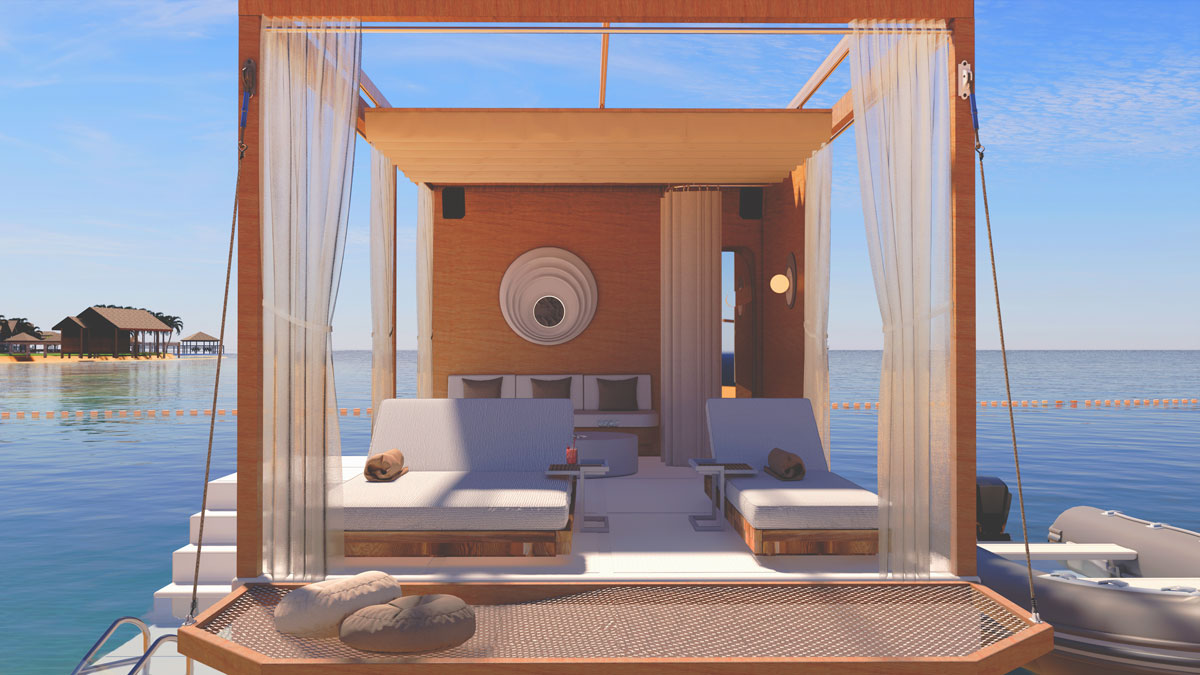
Beach holidays are no longer limited to the traditional trio of sea, sand, and sun. Today’s travelers crave unique experiences that blend relaxation with innovation. Enter the Floating Lounge, an innovative addition to waterfront properties [...]
Reclaiming coastal land can create valuable real estate, but its economic and environmental costs are too high. Using floating systems instead is not only more cost- and time-efficient, but also a more environmentally friendly alternative. As such, it might entirely replace land reclamation in the future.
Land reclamation is a method used to create more land space, especially in land-scarce countries. For instance, 25% of Singapore is made up of reclaimed land. 20% of Tokyo is made up of artificial islands. Since the beginning of 21st century, coasts have grown by an area about the size of Luxembourg. Many of these areas are in locations that have been designated as possibly exposed to high sea level rise.
Adding large amounts of artificial land to coasts significantly contributes to climate change which leads to extreme weather events. A recent study showed the negative effects of one of the most famous reclamation projects, Palm Jumeirah Island, on its surrounding water quality and temperature. The study showed that the construction of offshore island increased the water reflectance in the 0.5–0.8 µm of wavelength, which is the increase of suspended sediments and chlorophyll. What is even more striking is that the water temperature increased by 7.5 °C since its construction.

Material extraction for reclamation leads to degradation of natural ecosystems.
Land reclamation clearly requires a large amount of fill soil, usually sand. In most cases, the sand is dredged from deep seabed. The deposited sand is then compacted, a process which can take years to complete. The structures and infrastructure on reclaimed land might be damaged by time due to ground instability, ground settlement, and soil liquefaction. The economic cost of maintaining the system in operation is unsustainable. Reclaimed land needs ongoing, expensive upkeep to maintain stability of land.
Sand is globally the second most exploited resource after water. Countries are struggling to find sand that can be efficiently used for reclamation. Some countries have turned to importing land from other countries. However, various legal and environmental restrictions have been made to prevent the detrimental impact on the ecosystem. Knowing the fact that there is no more sand left to be used for reclamation, many countries are seeking new resource-efficient and sustainable methods to replace aggressive land reclamation.
Around the world, land reclamation projects have been carried out for a variety of reasons, such as urban development, agriculture, research, energy production. Considering the size of reclaimed land, China is the country with the most reclaimed land with 13,500 square kilometers added to its territory. It is followed by the Netherlands, with 7,000 km2 and South Korea with 1,550 km2. Land reclamation has played a significant role in the development and expansion of land-scarce cities such as Monaco, Singapore, New York in United States or Dubai in the United Arab Emirates.
One of the most recognizable recent land reclamation projects is The Palm Islands. It is a group of artificial islands: Palm Jumeirah, Palm Jebel Ali, and Palm Deira located in Dubai’s coats.

Palm Jumeirah and Palm Jebel Ali and the World Islands in Persian Gulf
Kansai International Airport, built in 1990s in Osaka, Japan, is an artificial island airport was constructed to address the limited land availability for an airport in the Osaka region.

Kansai Airport, Osaka, Japan
Monaco, a county with only 2.02 km2 has also used reclamation method to expand its area. Since 1970s the entire districts such as Fontvieille have been constructed on land reclaimed from the sea.

Fontvieille district, Monaco
Employing floating reclamation systems is better than conventional land reclamation solutions to create more space using water bodies. These structures are designed as floating platforms that are placed on water surface. They offer various opportunities for sustainable development and cost-efficient extension of land.
The floating foundation system (FFS), a unique kind of floating foundation created by HSB Marine, is a ground-breaking technology that enables floating on the water and offers a strong basis for erecting virtually any form of structure on it. FFS works with water, in contrast to reclamation methods, which work against it. The floating structure can never sink as it is buoyed aloft by a force equivalent to the weight of the water it displaces.
FFS can be produced quickly and affordably. Because of its portability, it can be successfully applied anywhere in the world. The FFS system is a practical, real-world solution that ensures complete stability on the water's surface.

Let’s compare both methods for the iconic land reclamation project Palm Jumeirah, Dubai, UAE.

The estimated cost of the original project was $12 billion. If the same land area was added using floating system, the estimated cost would be $8,4 billion.
It took 6 years to complete the land reclamation. However, producing the floating foundations for the same area would take 2.5, maximum 3 years.

Palm Jumeirah, Dubai
Palm Jumeirah used 120 million m3 of sand, rock, steel and filling materials extracted from seabed to reclaim the land. A floating system would need 35 million m3 of concrete.
Furthermore, it is scientifically proven that the project has serious negative impact on water ecosystem, increasing its temperature by 7.5 °C in 19 years. The impact of floating systems on marine life is minimal.
The environmental and economic costs of reclamation are too high. The invasive processes of land reclamation pose serious environmental risks. Before the ocean ecosystem is irreversibly damaged and sand entirely extracted, something needs to be done. Floating systems offer a sustainable and feasible solution that will leave reclamation behind.